Two Prunes and a Raisin, Baked on a Bus in Berlin
Dave the motorhome’s come close to a suitable temperature for spontaneous combustion today as a heatwave has hit the stellplatz here, in what used to be West Berlin. We’re about 15 minutes walk from the nearest S Bahn station, which then drops you off in the centre of the city after a 20 minute ride for €2.40 a ticket. Yep, Berlin’s a big old city, and after a wincingly-expensive trip into Starbucks, it’s back to Western prices with a bang!
About 800 years old, Berlin that is, but it doesn’t show its age. It looks young and fresh. It would do, after all, 70% of it was erased from the face of the Earth 70-odd years ago. Tonnes of bombs fell from British, American and Russian armadas in the sky, not that Berlin was a military target. Like the Luftwaffe bombing London, the idea was to break the morale of the population. Both sides failed in this, the people proved tougher than the destructions rained on them, but the buildings didn’t.
I’d read up a bit on Berlin as, I have to admit, I was pretty clueless about all this Berlin wall stuff. Sure, I knew there had been a Soviet-block Iron Curtain, a secure, militarised border running from the North Sea to the Adriatic, blocking East Germany, Czechoslovakia, Hungary and Slovenia from their ‘anti-revolutionary, imperialist’ neighbours to the West. I didn’t quite get the unique position of Berlin in all this. Once WW2 was over, the Allies got together at Potsdam to decide on how they’d govern Germany. The decision taken was a bit of a weird one; the Russians would get the area to the North East of the country, but within that block of land sat Berlin. Rather than handing over control of the entire city to the Reds, it too was partitioned, with the Allies controlling the Western area. This meant that West Germany was made up of a whacking block of contiguous land, plus a little island in Russian territory – West Berlin. The Allies were afforded access to the island via a land route, at least until Stalin went a bit loopy over policy arguments and cut this route off, kicking off a huge year-long air drop to enable West Berlin to stay, erm, Western. Later on, as economic and social conditions in the East worsened, the best and brightest from the East left, crossing the unsecured border to the West Berlin island and from there to the West. This annoyed the Russians somewhat, who eventually surrounded all of West Berlin with a fence, then a wall, then two walls with a ‘death zone’ between them. Crossing from East to West was only possible under the strictest of conditions, or by using a hot air balloon.
History’s never as simple as it looks though. I was also under the impression that Germany was desperate to re-unify the country as soon as possible, and the West was desperate for the Berlin Wall to fall. Seems neither are entirely true, Stalin offered to re-unify Germany in 1952 (with conditions attached of course) and the late Baroness Thatcher pleaded with the Russians not to let the wall fall, shortly before it did.
We’ve taken a tour of the city today, the lazy way, buying a couple of two-day tickets for the hop-on, hop-off bus at €20 each (the leaflet advertising it says it €22, but we’re not arguing). The bus tours the city in a two and a half hour loop, allowing you to get on and off when you like, with comically wooden, passionless commentary in a range of languages. It takes in an endless concoction of monuments, buildings old and new, museums, churches, historically iconic places and, of course, shops. We’ve used these tour buses in a few cities now, and they’ve always been worth the money enabling us to get a snapshot of the city quickly and (relatively) cheaply.
Sure, we could use public transport and cut out a few quid but hey, it’s been 35 degrees today, and we just couldn’t be bothered (the ground floor of the buses are, wonderfully, air conditioned to some degree). Oh, and Ju was on BBC Radio last night, being interviewed by Dean Jackson as ‘ex-pat of the week’. She’s done a slot before while we were in Spain, and both times it means she has to stay up until about 2am. It’s good fun though, and I lay and listened to half a conversation as she attempted to explain to the British public what a ‘stellplatz’ is. She’s my wife, so I’m biased, but I reckon she does a stunning job of explaining our weird life in about 15 minutes of air time.
Rather than talk through our day of wandering about, which might take an age, here’s a quick summary of what I recall of Berlin after a single day:
- Berlin, and by extension the whole of Germany, has made a massive effort to highlight the history and horror of the Nazi era. Monuments and information points abound. Outside the Brandenburg gate as we emerged from the S Bahn station there’s a huge information board and photos of soldiers rounding up scared looking folks in the 1930s. In the park opposite stands a memorial to murdered Roma (Gypsies). There’s a huge sculpture to the 6 million Jews who perished in the holocaust – a field of monoliths which I couldn’t help but having fun wandering around like a maze. The site of the old SS headquarters has been levelled but holds a massive information board, depicting everything from book-burning and rallies to more scared faces stood against a wall. It’s always intrigued me how Germany as a nation could re-emerge from such a terrible position in the 1940’s to being a leading light of Europe. Nothing is hidden, even the location of Hitler’s long-gone bunker, the site of his last-minute marriage and follow-on suicide, has been marked with an information board since 2006, despite fears of neo-Nazis using the area as a shrine.
- The city feels wide open and airy. As above, I guess it was less so before the bombers reduced it to rubble. Huge efforts have clearly taken place to rebuilt as blocky granite, steel and glass structures rise up in monumental proportions in places. Sadly, although there is a scattering of pre-war buildings, much of the good stuff which gave the city its unique heritage has gone, the buildings now rising from the ashes grow all over the affluent world, looking much the same everywhere.
- The East-West divide is, to me, invisible. It’s marked out on maps and here and there tiny bits of wall stand to de-mark the division between communism and free-market capitalism, but without them I’d see no difference and I couldn’t tell which half we were in as we criss-crossed the invisible divide. It’s pretty obvious cash must have flooded in a West-East direction in the past 20 years. You can drive a Trabant car in a convoy around the city, and here and there information about the suppression of trade unions and uprisings is displayed on walls. We’re also told there’s still a separation in thinking between the Easterners and Westerners – like a sideways-on North-South divide, but obviously nothing was visible to us.
There’s so much to Berlin, and we’ve not been inside a single museum, art gallery, theatre or monument or, ahem, beer hall, since we can’t leave Charlie alone in the heat. The weather forecast for tomorrow says it’ll be hotter: 38 degrees, nasty! We have our pitch here paid for so we could get back into town, but it’s been a wee bit of an endurance test today in the heat and the crowds (especially for poor Charlie), so we’re thinking of taking a ‘rain check’ on a second view of Berlin tomorrow. Shame, as we’ll miss out on a lot, but Berlin’s not exactly hard to get to by plane so that might be a better way for us to investigate the place some day in the future, we’ll see.
- Outside the Brandenburg Gate, a huge information board tells of the gradual loss of liberty in the 1930’s.
- The Brandenburg Gate, packed with punters,
- A new memorial to the Roma killed by the Nazis. We looked in vain for a memorial to those killed crossing the wall, but it seems it has been demolished.
- More gut-spilling out side the Reichstag.
- Part of the huge steel and glass Sony Centre
- Sony Centre, with a roof said to resemble a Japanese volcano and coffee prices which require a mortgage
- Mogwai, he’s no square
- An info board next to the Holocaust Memorial
- The Holocaust Memorial, a maze of blocks and a museum beneath
- The Holocaust Memorial
- The Holocaust Memorial
- This is the East German (GDR) version of the Little Green Man. An effort to standardise all the lights on the same (Western version of the) character failed after popular dissent. We like the little hatted chap.
- The Wall.
- Party time.
- More Wall.
- This many punters = cheesy blokes selling ‘passport stamps’ to the East.
- If Apple were architects?
- The site of Hitler’s bunker complex. The Soviets destroyed much of it, just a few tunnels remain, but nothing’s been preserved for the public. Hitler’s body guard was present at the unveiling of the little sign Ju’s reading.
- Sculpture in Berlin.
- A mural telling it like it was supposed to be in the East.
- Happy socialist families, no sign of the Stasi (secret police) in this painting though?
- Trabant!
- More Trabant!
- Erm, postcards…!
- A section of wall alongside the old SS/Gestapo HQ (long since demolished)
- More Wall.
- Reminders of the past. Where did it all go wrong?
- We came across a large march in the city.
- They were demonstrating against goverment-backed espionage against their own populations. In other words it was an anti-US march.
- Looking West at Checkpoint Charlie, a Wall crossing point.
- Looking East at Checkpoint Charlie.
- Ju prepares to leave the American Sector with Checkpoint Charlie the pooch!
- Checkpoint Charlie. More blokes flogged passport stamps here. The one near us happily responded to a request to spray Charlie with water, cooling our little fella somewhat.
- OK, I’ve no idea what this, but it’s one of the few ‘old bits; of Berlin
- The Red Church, named for obvious reasons
- Art on The Wall
- Art on The Wall
- Random advert – no idea what for though!
- The odd hint of the East remains
- The TV Tower
- A Prune and a Canine Raisin tour Berlin on a hot bus
- More TV Tower, an icon of the East
- Yeah! Free Bradley, dammit. The protester numbers dwindle as they reach the baking Brandenburg Gate
- The Bradenburg Gate, with a roasting sun beyond.
- Go lads go. We spotted these chaps twice over the course of several hours – English guys and they must have drunk as much as they sweated out!
Cheers, Jay

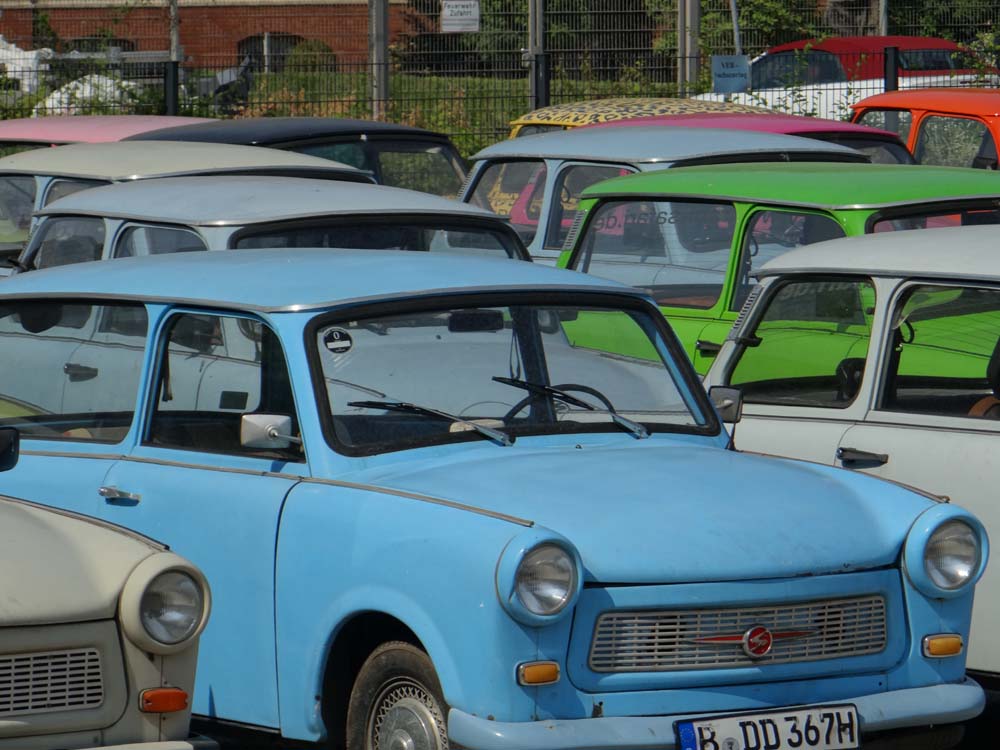
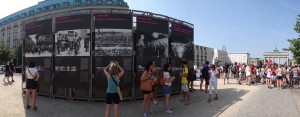

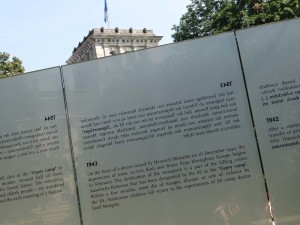

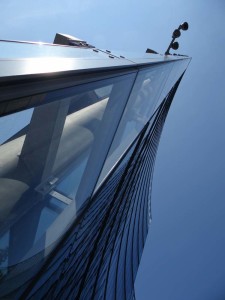

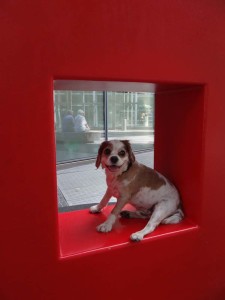
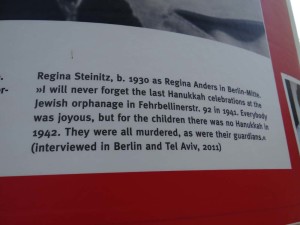
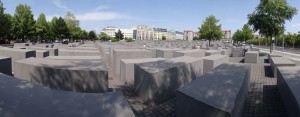
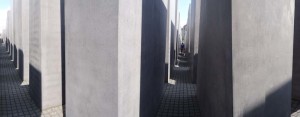
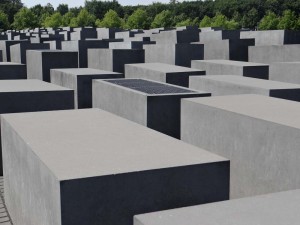
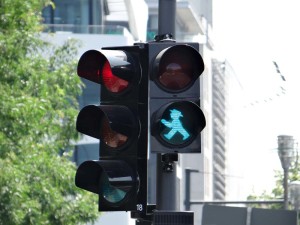

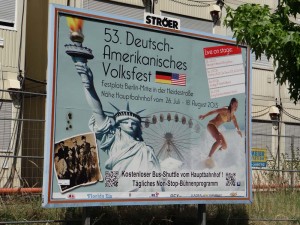
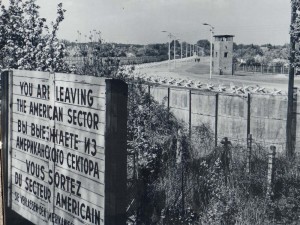
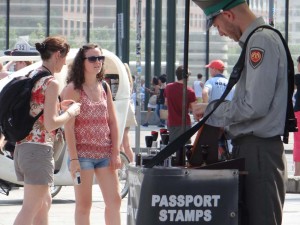
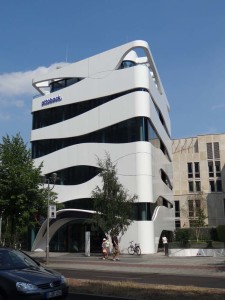
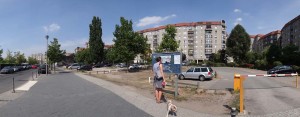
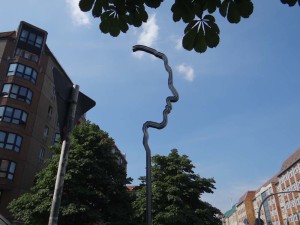
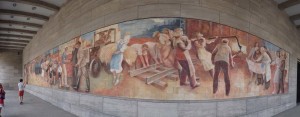
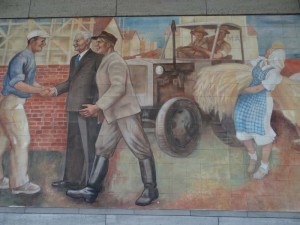
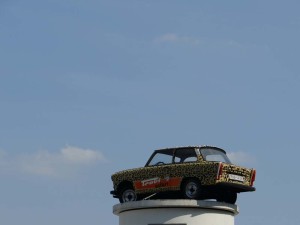

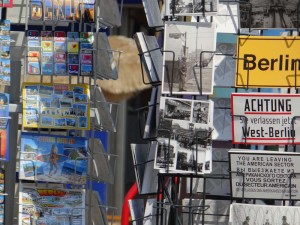

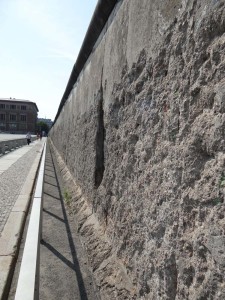
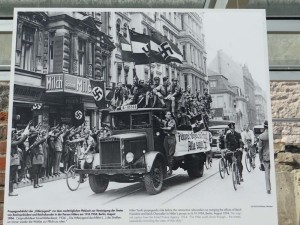
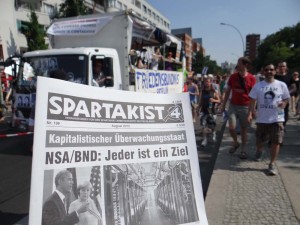
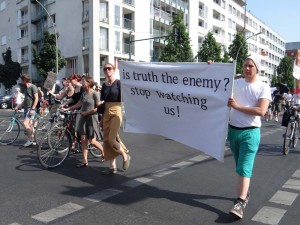
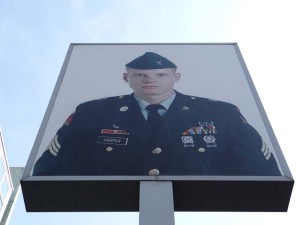

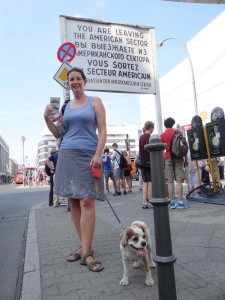
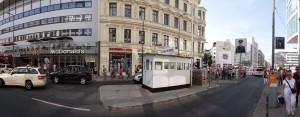
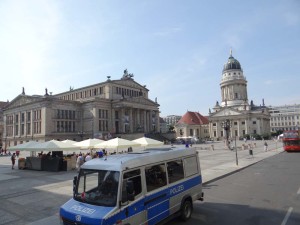

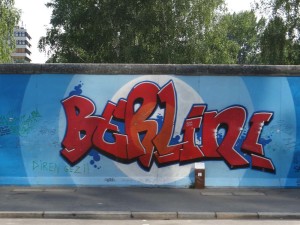

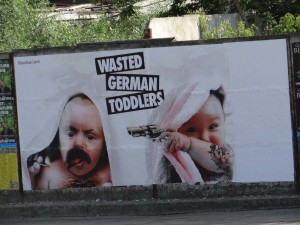
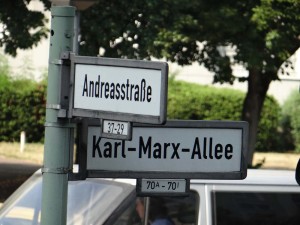
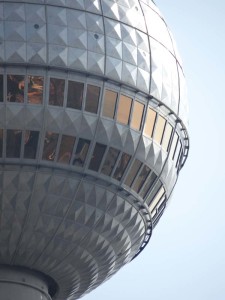
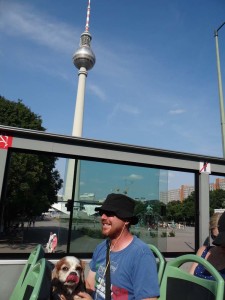
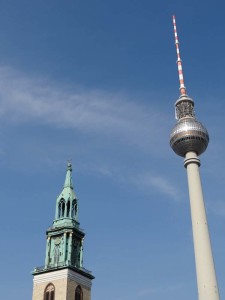

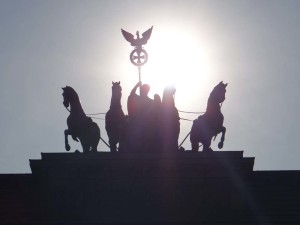
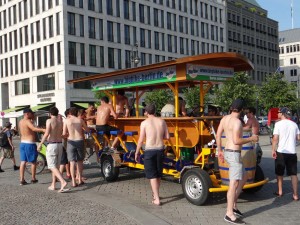

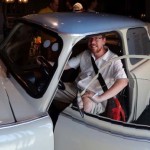
Hi,
Yes you are right about investment in East and West Berlin, foreign aid was not the only thing though, all West German citizens had 10% put on the phone bill! Additionally the first 15 years were spent on sorting out pollution in the East, factories, waterways etc only when this phase was completed did they begin to “sort out” other things.
We lived in Germany for 18 Years and went to Berlin many times, it truly is a remarkable place. Don’t forget the Reichstag, and the Russian war memorial, the Blue Church and Stuckenburger Platz and loads of other things, oh and don’t forget to have a Berlinner Weiss Beer, Happy travels we set off in 5 weeks for our month away!
Mike n June
Hi, great info – we are looking for stellplatz to visit Berlin – do you have coordinates of some please? Thx M :)
Hi Marianne
I’ve only got the details of the place we stopped at. It’s website is http://www.stellplatz-berlin.de and the GPS is 52o 35′ 42″ / 13o 17′ 19″.
Cheers Julie